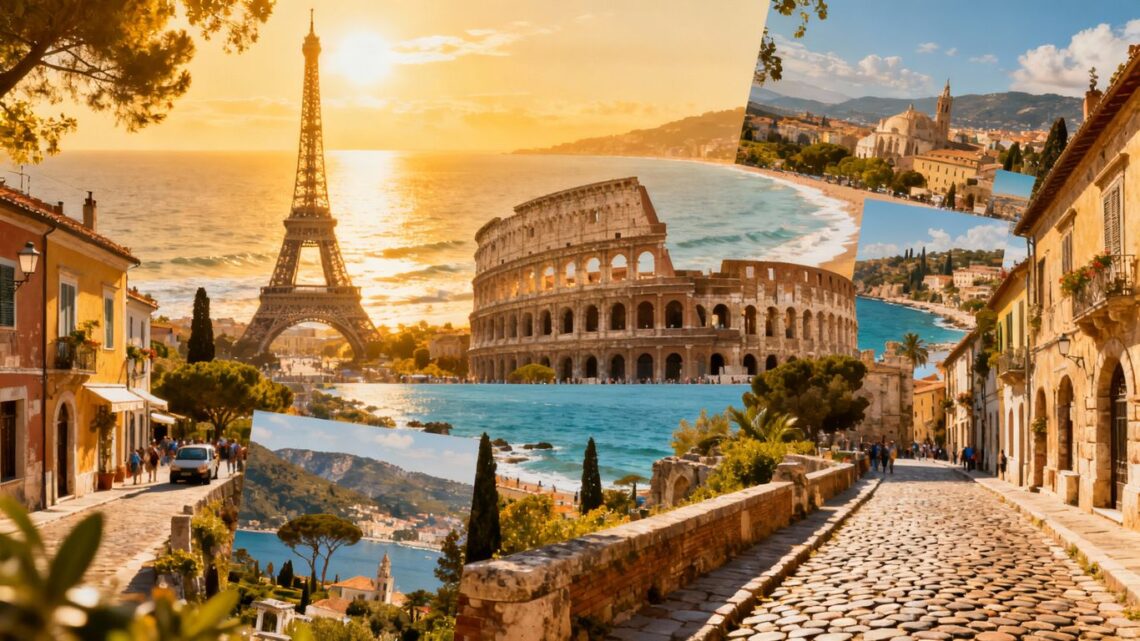Thinking about exploring Europe without emptying your wallet? It’s totally doable! Forget those pricey postcards from Paris or Rome for a second. There are so many amazing places to travel cheap in Europe that offer incredible culture, stunning sights, and delicious food, all while being kind to your bank account. This guide is all about showing you how to make that European adventure a reality, even on a tight budget. We’ll cover where to go and how to get around smart.
Key Takeaways
- Eastern Europe often provides more value for your money compared to Western Europe, offering rich culture and beautiful scenery at lower costs.
- Opting for hostels, guesthouses, or even considering campervans can significantly cut down accommodation expenses.
- Utilizing budget airlines, buses, ridesharing, and walking or biking within cities are great ways to save on transportation.
Embrace Eastern Europe For Budget-Friendly Adventures

When you think of Europe, maybe Paris or Rome pops into your head first. Those places are amazing, no doubt, but they can also really put a dent in your wallet. If you’re looking to stretch your travel funds further, you’ve got to consider looking east. Eastern Europe is where it’s at for incredible experiences without the hefty price tag.
Discover Affordable Gems Beyond Western Europe
Forget the idea that you have to spend a fortune to see beautiful architecture or soak up rich history. Countries like Poland, Hungary, and the Czech Republic offer stunning cities that rival their Western counterparts, but at a fraction of the cost. Think about Krakow, with its charming old town and Wawel Castle, or Budapest, famous for its thermal baths and grand Parliament building. Even smaller cities pack a punch. For instance, Wroclaw in Poland is often called the ‘Venice of Poland’ with its many islands and bridges, and it’s way more affordable than Venice itself.
Here are just a few places that offer amazing value:
- Albania: Seriously underrated. Think beautiful coastlines on the Ionian Sea that rival Greece, but with prices that feel like a throwback. You can find great food and places to stay without spending much.
- Bulgaria: Sofia is a lively capital, and Plovdiv is one of Europe’s oldest continuously inhabited cities. You get history, culture, and Black Sea beaches, all very budget-friendly.
- Lithuania: Vilnius has a stunning Baroque old town and is surprisingly affordable. It’s a great entry point to the Baltic region, which is generally kind to your wallet.
It’s not just about the big cities either. Exploring the countryside in places like Romania or Georgia can be incredibly rewarding and cheap. You can find guesthouses in the mountains that often include meals for a very reasonable price, making it a fantastic option for nature lovers who want to avoid the high costs of places like Switzerland.
Traveling off-season, like from January to March, can slash accommodation costs by up to 40%. It’s a smart move if you can swing it, as you’ll also deal with fewer crowds.
Experience Authentic Culture Without Breaking The Bank
One of the best things about traveling in Eastern Europe is how genuine the experiences often feel. Because these places aren’t as overrun with tourists as some Western European hotspots, you often get a more authentic slice of local life. You can wander through markets, chat with locals (even with a language barrier, a smile goes a long way!), and really get a feel for the place.
Trying local food is a big part of any trip, and in Eastern Europe, it’s usually delicious and cheap. You can find hearty meals in local eateries for just a few euros. Imagine enjoying a plate of pierogi in Poland or a warming goulash in Hungary without feeling guilty about the cost. It’s about savoring the flavors and the moments, not just ticking off sights.
- Local Markets: These are goldmines for cheap eats and souvenirs. You can often grab fresh produce, local cheeses, and baked goods for very little.
- Public Transport: Getting around cities and between towns is usually very affordable. Buses and trains are common and much cheaper than in Western Europe.
- Free Activities: Many cities have beautiful parks, historic streets to wander, and free walking tours that give you a great overview without costing anything.
So, if you’re dreaming of a European adventure but worried about the budget, definitely put Eastern Europe on your list. You might be surprised at just how much amazing stuff you can see and do without emptying your bank account.
Smart Strategies For Traveling Europe On A Shoestring

Traveling Europe doesn’t have to drain your bank account. With a few smart moves, you can see incredible places without spending a fortune. It’s all about being a bit savvy with your choices.
Leverage Hostels And Alternative Accommodations
Forget fancy hotels; hostels are your best friend when traveling Europe on a budget. They’re not just cheap; they’re also great places to meet other travelers. You can get a dorm bed for as little as €15-€30 a night in many cities. Plus, many hostels have kitchens, which means you can save even more money by cooking some of your own meals instead of eating out all the time.
Beyond hostels, think about guesthouses or even renting a room in a local’s apartment. Sometimes, staying a little further from the absolute city center can significantly cut down costs, as long as you’re near good public transport links. You might even find places offering longer-term stays at a discount if you’re planning to hang around for a while.
- Hostels: Great for solo travelers and meeting people.
- Guesthouses/B&Bs: Often a bit quieter than hostels, with private rooms.
- Apartment Rentals: Good for groups or longer stays, offering kitchen facilities.
- Volunteering: Some programs offer free accommodation in exchange for a few hours of work per day. It’s a unique way to experience a place and meet locals.
When looking for a place to stay, always check reviews. A cheap place that’s dirty or unsafe isn’t worth the savings. Look for places with good common areas and maybe even a free breakfast to start your day right.
Master The Art Of Cheap Transportation
Getting around Europe can add up fast, but there are ways to keep those costs down. Buses are often the cheapest way to travel between cities, especially in Eastern Europe and the Balkans where train networks might not be as developed. Companies like FlixBus or Eurolines offer extensive routes at very low prices, especially if you book in advance.
Budget airlines are also a big player. Carriers like Ryanair, EasyJet, and Wizz Air can get you across the continent for incredibly low fares, sometimes as little as €20 round trip. Just be super careful about baggage fees – they can quickly turn a cheap flight into an expensive one. Pack light, stick to carry-on if you can. Also, double-check where the airport is located; sometimes, the cost and time to get from a far-flung airport can wipe out your savings.
Here are some transport options to consider:
- Buses: Generally the most budget-friendly for inter-city travel.
- Budget Airlines: Great for longer distances, but watch out for extra fees.
- Trains: Can be cost-effective if booked in advance, especially with passes for extensive travel.
- Ridesharing: Services like BlaBlaCar connect you with drivers going your way, often cheaper than trains or buses.
| Transport Type | Average Cost (per 100km) | Booking Tip |
|---|---|---|
| Bus | €5 – €15 | Book 2-4 weeks ahead |
| Budget Flight | €15 – €40 (excl. bags) | Book 1-2 months ahead |
| Train | €10 – €30 | Look for off-peak tickets |
| Rideshare | €5 – €12 | Flexible with departure time |
Savor Local Flavors Without Overspending
Eating out every meal can be a huge budget killer. The trick is to mix it up. Hit up local markets for fresh produce, bread, cheese, and meats – perfect for picnic lunches or cooking in your hostel kitchen. You’ll get a real taste of local life and save a ton.
When you do eat out, avoid the tourist traps right on the main squares. Wander a few streets away, and you’ll find places where locals actually eat, with better food and prices. Look for daily specials or ‘menu del dia’ (menu of the day) deals, which are usually a fantastic value. Street food is also your friend – think crepes in France, bratwurst in Germany, or gyros in Greece. It’s delicious, cheap, and a quintessential part of the travel experience.
- Picnics: Buy from local markets for cheap and tasty lunches.
- Cook: Utilize hostel or apartment kitchens whenever possible.
- Local Eateries: Venture off the main tourist paths for authentic and affordable meals.
- Street Food: A quick, cheap, and delicious way to sample local snacks.
- Happy Hour/Lunch Deals: Take advantage of special offers during off-peak dining times.
So, Go Explore!
Alright, so maybe Europe doesn’t have to cost an arm and a leg after all. We’ve gone over a bunch of ways to see this amazing continent without emptying your wallet. Think about hitting up Eastern Europe, traveling in the spring or fall, and maybe even trying out a hostel or a campervan. It’s totally doable to have an awesome trip, see incredible places, and still have money left over for, you know, actual food. Don’t let the price tag scare you away from experiencing all the cool stuff Europe has to offer. Get out there and make some memories!
Frequently Asked Questions
When is the cheapest time to visit Europe?
To save the most money, try visiting Europe during the spring (late March to mid-June) or fall (September to early November). During these times, the weather is usually still great, there are fewer crowds, and prices for flights and places to stay are often lower than in the busy summer months. Avoid July and August if you want the best deals.
What are some budget-friendly European destinations?
Instead of the usual expensive spots, check out Eastern Europe! Countries like Albania, Romania, Bulgaria, Poland, and the Baltic states offer amazing culture, beautiful sights, and delicious food without costing a fortune. You can explore mountains, beaches, and historic towns for a fraction of the price you’d pay in Western Europe.
How can I save money on accommodation and getting around Europe?
Hostels are a fantastic way to save money on lodging and meet other travelers. Many offer kitchens where you can cook your own meals, which is another great way to cut costs. For getting around, buses and trains are usually the cheapest options. Look into budget airlines for longer distances, but be mindful of extra baggage fees. Sometimes, renting a car can be surprisingly affordable, especially if you’re exploring smaller towns or rural areas.






